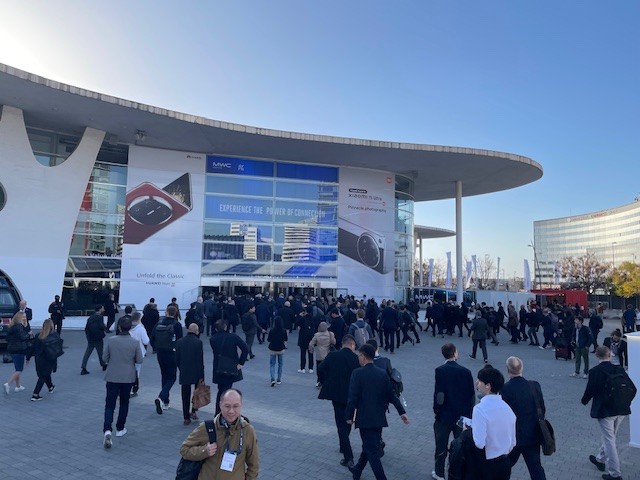Mobile World Congress: a look back at an unmissable trade show

Tens of thousands of square metres, over 100,000 visitors from 205 countries, over 2,900 exhibitors, over 1,200 speakers at various conferences, numerous announcements of product launches, partnerships and fund-raising: a titanic scale reflecting the economic and industrial weight of the sector. A delegation from the ANFR went there not to miss out.
As well as showcasing technological trends, this not-to-be-missed trade fair provides an opportunity for bilateral meetings and exchanges with the ANFR's counterparts, notably as part of the ministerial programme set up by the GSM Association, the mobile operators' association, which organises the event.
Satellite communication to mobile terminals: at the heart of the debate and discussions
A half-day conference on satellite communications solutions (D2C/D2D) attracted a full house. Numerous stands presented solutions and prospects in that field, demonstrating the dynamic nature of investment in the sector.
Gilles Brégant, Director General of the ANFR, spoke at a session in which spectrum managers from various regions shared their views on the challenges of D2C/D2D. On that occasion, the ITU-R reminded of the existence of several items on the agenda of the 2027 World Radiocommunication Conference that will make it possible for these new uses to be better organised. In particular, item 1.13 will define the international framework, while regulatory initiatives are already under way in the United States and Europe, for example, where the RSPG is consulting on these new services. A bilateral meeting was also held to discuss the possibilities of measuring satellite emissions in order to verify their compliance, as well as the limits that could be imposed.
Visits, trends and discussions
The ANFR delegation visited a large number of stands run by equipment manufacturers, operators, component suppliers and measurement equipment manufacturers, to get a better idea of the innovations and technological developments in the radio sector.
A number of fundamental trends are at work: integration of low and high bands in single racks, reduction in the weight and power consumption of base stations, innovations and increase in the number of active antenna elements, virtualisation of many functions. Millimetre bands are still a challenge for mobile services beyond remote subscriber line (FWA) solutions, but some highlight other possibilities, such as communications with drones.
Over the course of the interviews, the ANFR staff were able to identify a number of key issues: the uses envisaged in Europe for the high 6 GHz band, the future of the UHF band, the evolution of uses in the 2 GHz MSS band and, of course, the direct connection between satellite constellations and smartphones (D2D/D2C).
During the trade show, Gilles Brégant had discussions with the Director General of ETSI and Eric Fournier, Director of the DPSAI and candidate for the post of Director of the ITU Radiocommunication Bureau, who also took the opportunity to start focusing his campaign on the other continents a few days after the positive outcome of the CEPT indicative vote.
Mobile networks: who's the star?
Artificial intelligence, a major theme at last year's show, remains omnipresent, with solutions for managing and planning the deployment of mobile networks more effectively, for example. Edge computing is a promising way of reducing the need for data centres, which consume energy and raise issues of sovereignty. Communications and products on the stands this year focused mainly on 5G advanced. As for 6G, it will have to wait a little longer to become the star of the show, even if its presence is beginning increasingly visible.

